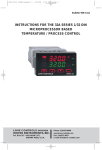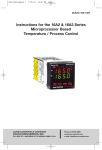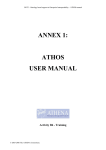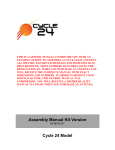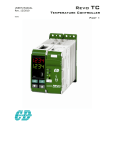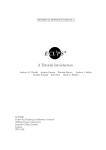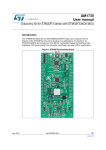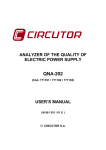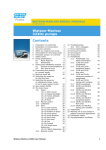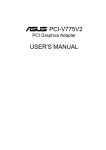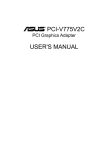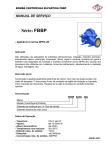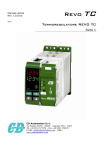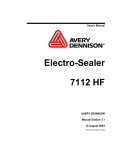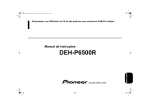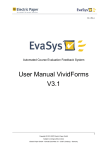Download 32DZ - Dwyer Instruments, Inc.
Transcript
INSTRUCTIONS FOR THE 32DZ SERIES 1/32 DIN DUAL ZONE MICROPROCESSOR BASED TEMPERATURE /PROCESS CONTROL LOVE ® June, 2000 LOVE CONTROLS a Division of Dwyer Instruments, Incorporated PO Box 338 ❍ Michigan City, IN 46361-0338 (800) 828-4588 ❍ (219) 879-8000 ❍ FAX (219) 872-9057 www.love-controls.com Page 1 of 40 949-1318 Contents INSTALLATION ....................................................................................... 3 WIRING ................................................................................................... 5 Wiring for Optional Inputs and Outputs ................................................... 6 Wiring for 4 to 20mA Transmitter inputs ................................................. 7 FRONT PANEL KEY FUNCTIONS ......................................................... 8 NOTATION CONVENTIONS FOR THE MENUS .................................. 10 THE HOME DISPLAY ........................................................................... 10 ALARM TYPE AND ACTION ................................................................ 11 OPERATION OF SELF TUNE® FUNCTION ......................................... 12 Theory of Operation .............................................................................. 12 Program Setup and Operation ............................................................... 13 OPERATION AND PROGRAMMING OF OPTIONS ............................. 13 Option 992, Serial Communication. ...................................................... 13 FACTORY DEFAULT PROCEDURE .................................................... 14 MENU SELECTIONS ........................................................................... 14 PRIMARY MENU .................................................................................. 14 SECONDARY MENU ............................................................................ 15 SECURE MENU .................................................................................... 25 SPECIFICATIONS ................................................................................ 35 DIAGNOSTIC ERROR MESSAGES ..................................................... 37 DIAGNOSTIC ERROR MESSAGES ..................................................... 38 DIMENSIONS ....................................................................................... 40 © 2000, Love Controls, a division of Dwyer Instruments, Incorporated. All rights reserved. No portion may be copied without the express written consent of Love Controls. 949-1318 Page 2 of 40 June, 2000 MODEL IDENTIFICATION Model 3 2 D Z — Options Input 1 1 = Thermocouple J,K,E,L,N 2 = Thermocouple T,R,S,B,C 3 = 100 and 120 ohm RTDs 4 = 1000 Ohm RTD 5 = Current, 0 or 4 to 20 mA 6 = Voltage, 0 or 2 to 10 V Input 2 1 = Thermocouple J,K,E,L,N 2 = Thermocouple T,R,S,B,C 3 = 100 and 120 ohm RTDs 4 = 1000 Ohm RTD 5 = Current, 0 or 4 to 20 mA 6 = Voltage, 0 or 2 to 10 V Output B 1 = SSR 2 = Switched Voltage 5 Vdc 3 = Relay 8 = DC SSR Output A 1 = SSR 2 = Switched Voltage 5 Vdc 3 = Relay 5 = Proportional current 8 = DC SSR Options: 992 9502 RS-485 Serial Communications. Allows remote computer to read and write all control parameters. 12 - 24 Vdc/Vac 50-400Hz power supply (control operates on low voltage equipment). INSTALLATION All models are designed for mounting in an enclosed panel. Select the position desired for the instrument on the panel. If more than one instrument is required, maintain the minimum of spacing requirements as shown on the drawing opposite. Closer spacing will structurally weaken the panel, and invalidate the IP66, UL type 4 rating of the panel. It is not necessary to remove the instrument chassis from the housing for installation. If the instrument chassis is removed from the housing, you must follow the ANSI/IPC-A-610 standard for handling electronic assemblies to avoid damage from Electro-Static Discharge (ESD). Failure to properly handle the instrument may cause damage to the instrument. June, 2000 Page 3 of 40 949-1318 Prepare the panel by cutting and deburring the required opening(s). 25.4 (1.00) 45 + 0.6 (1.772 + 0.02) 20.5 (0.807) 22.2 + 0.3 (0.874 + 0.012) From the front of the panel, slide the housing through the cutout. The housing gasket should be flat against the housing flange before installing. Panel Collar Gasket From the rear of the panel slide the mounting collar over the housing. Hold the housing with one hand and using the other hand, push the collar evenly against the panel until the spring loops are slightly compressed. The ratchets will hold the mounting collar and housing in place. To remove, gently lift the ratchets and slide a piece of heavy paper or mylar sheet under each ratchet (a business card works well). Slide the collar off of the housing. 949-1318 Page 4 of 40 June, 2000 WIRING WARNING: The inputs of the instrument are not isolated from each other. The input sources must be isolated from each other. Thermocouples MUST be of the isolated junction type. Process inputs may not share a common external ground. FAILURE TO OBSERVE THIS WARNING MAY CAUSE DANGEROUS OR LETHAL VOLTAGES TO BE PRESENT IN THE INSTRUMENT WHICH MAY CAUSE SERIOUS INJURY OR DEATH. DO NOT RUN SIGNAL (CLASS 2) WIRING IN THE SAME CONDUIT OR CHASE AS THE POWER WIRING. ERRATIC OPERATION OR DAMAGE TO THE INSTRUMENT CIRCUITRY WILL RESULT. Use only the type of thermocouple or RTD probe for which the control has been programmed. Maintain separation between wiring of sensor, auxiliary in or out, and other wiring. See the "Secure Menu" for input selection. For thermocouple input always use extension leads of the same type designated for your thermocouple. For supply connections use No. 18 AWG wires rated for at least 75°C. Use copper conductors only. All line voltage output circuits must have a common disconnect and be connected to the same pole of the disconnect. Input wiring for thermocouple, voltage, current, and RTD; and output wiring for current, DC SSR, and 5 VDC is rated CLASS 2. June, 2000 Page 5 of 40 949-1318 Control wiring is as shown. The wiring terminals for the 32DZ are compression type. To open the wiring terminal, turn the screw for that terminal counterclockwise. Slide the wire into the terminal space. While holding the wire in place, turn the screw clockwise to tighten. Maximum torque is 0.424 N·m(3.75 in. lb.). Do not overtighten. The wire should be held snugly in place. Wiring for Optional Inputs and Outputs Wire power and outputs as shown. Wiring for options is shown below. All wiring shown below is Class 2. Shielded twisted pair is required for Option 992. Option 992: Terminal 5 is line A (-). Terminal 6 is line B (+). Last control in chain must have 120 ohm ± 1% resistor across 5 and 6. Option 9502: Connect 12 to 24 Volt ac or dc power to terminals 11 and 12. No polarity. Note: Industry standard designation for 11 12 5 6 RS-485 lines is A and B. Some equipment manufacturers use a non-standard designation of plus and minus. The association of A to minus and B to plus is based on a sample of devices marked as plus and minus and is not intended to represent ALL such labelled devices. Final responsibility for correct identification of leads and terminals rests with the user/ installer and the manufacturer of the other device(s) installed in the system. 949-1318 Page 6 of 40 June, 2000 Wiring for 4 to 20mA Transmitter inputs WARNING: The inputs of the instrument are not isolated from each other. The input sources must be isolated from each other. Process inputs may not share a common external ground. FAILURE TO OBSERVE THIS WARNING MAY CAUSE DANGEROUS OR LETHAL VOLTAGES TO BE PRESENT IN THE INSTRUMENT WHICH MAY CAUSE SERIOUS INJURY OR DEATH. Wire power and outputs as shown above. Two-wire transmitters wire as shown below. External Power Supply Transmitter 24 Vdc - + + - Wiring for Z1 Input External Power Supply Transmitter 24 Vdc - + + - Wiring for Z2 Input For three or four wire transmitters follow the wiring instructions provided with your transmitter. DO NOT WIRE THE 24 VOLT POWER SUPPLY ACROSS THE INPUT OF THE CONTROL. DAMAGE TO THE INSTRUMENT INPUT CIRCUITRY WILL RESULT. June, 2000 Page 7 of 40 949-1318 FRONT PANEL KEY FUNCTIONS Set Point 1 Lamp SP1 Process Z1 Set Point 2 Lamp Display Scale Lamp °F Z2 SP2 Process Scale Lamp °C Display SERIES 32DZ The decimal point flashes when Self-Tune is operating. Keys are illuminated when pressed. Key functions are as follows: INDEX: Pressing the INDEX key advances the display to the next menu item. May also be used in conjunction with other keys as noted below. UP ARROW: Increments a value, changes a menu item, or selects the item to ON. The maximum value obtainable is 9999 regardless of decimal point placement. DOWN ARROW: Decrements a value, changes a menu item, or selects the item to OFF. The minimum value obtainable is -1999 regardless of decimal point placement. ENTER: Pressing ENTER stores the value or the item changed. If not pressed, the previously stored value or item will be retained. The display will flash once when ENTER is pressed. UP ARROW & ENTER: Pressing these keys simultaneously brings up the secondary menu starting at the alarm, tune, or cycle item (depending on programming). Pressing these keys for 5 seconds will bring up the secure menu. INDEX & DOWN ARROW: Pressing these keys simultaneously will allow backing up one menu item, or if at the first menu item they will cause the display to return to the primary menu. If an alarm condition has occurred, these keys may be used to reset the alarm. INDEX & ENTER: Pressing these keys simultaneously and holding them for 5 seconds allows recovery from the various error messages. The following menu items will be reset: OPEn InP: Input error message bAd InP: Input error message CHEC CAL: Check calibration error Correct the problems associated with the above conditions before using these reset keys. More than one error could be present. Caution is advised since several items are reset at one time. While in the Primary or Secondary Menu, if no key is pressed for a period of 30 seconds, the display will return to the HOME position displaying the 949-1318 Page 8 of 40 June, 2000 temperature value. While in the Secure Menu, if no key is pressed for a period of 60 seconds, the display will return to the HOME position displaying the temperature value. Outputs are disabled (turned off) when the Secure Menu is active. NOTE: To move to the Primary Menu quickly from any other menu, press the UP ARROW & ENTER keys followed by pressing the INDEX & DOWN ARROW keys. SECURITY LEVEL SELECTION Four levels of security are provided. The display shows the current security level. To change security levels change the password value using the UP ARROW and DOWN ARROW keys and pressing the ENTER key. Refer to the password table (following) for the correct value to enter for the security level desired. The SEC1 or SEC2 menu items security level may be viewed or changed at any time regardless of the present security level. To set the access level to, for example, 2 , at the SEC1 menu item press the UP ARROW key until the upper display shows the password, 1101 1101. Press the ENTER key. The display will blink, and return with the level value, 2 , in the upper display. The password values shown in the table cannot be altered, so retain a copy of these pages for future reference. This is the only reference made to password values in this instruction book. PASSWORD TABLE Menu Security Level Status Displayed Value When Viewed Password Value To Enter Primary Secondary Secure Locked Locked Locked 1 1110 Primary Secondary Secure Unlocked Locked Locked 2 1101 Primary Secondary Secure Unlocked Unlocked Locked 3 1011 Primary Secondary Secure Unlocked Unlocked Unlocked 4 111 June, 2000 Page 9 of 40 949-1318 NOTATION CONVENTIONS FOR THE MENUS Because of the number of features available in this control, information is included that may not apply to your specific control. All usable features are included in this book, but may not be used in your process. To increase clarity the following conventions are used: 1. Certain features, Menu Items, and functions shown in this book may or may not appear on your control, depending on other Menu Item selections. At various places in the Menus there are notes identifying Menu Items that "control" or "direct" other menu items. If you are looking for a particular menu item and can't find it, check the menu item that is its "control" for proper setting. 2. The "#" symbol is used in two ways. It is used inside a group of characters to indicate which set point function (SP1 or SP2) is being affected. It is also used before a group of characters of a menu item to indicate that there may be more than one selection or value for that menu item. This is used for certain repeated items such as in the Ramp/Soak Program section. 3. Features that apply only to Options will be printed in Italics. THE HOME DISPLAY The home display is the normal display while the control is operating. If no errors or functions are active, the HOME display will indicate the Process Variable (the temperature, pressure, flow, RH, etc., that is being measured) for Set Point 1 on the top display and the Process Variable for Set Point 2 on the bottom. THE MENU EDIT FUNCTION The Menu Edit function (Edit) allows quick access to operational and set up menu items for either or both of the zones. The Edit menu item appears at the top of the Secondary Menu and allows selection of the set point parameters. Setting Edit to 0 allows access to only the Peak (PEA1 and PEA2), Valley (UAL1 and UAL2), Local/Remote (LOre), and address (Addr) menu items. Setting Edit for either 1 or 2 allows access to the Secondary and Secure Menus for the zone selected. Setting Edit for 3 allows access to both the Secondary and Secure Menus for both Zone 1 and Zone 2. Each menu presents the menu items for Zone 1 first, followed by the menu items for Zone 2, followed by any common menu items that may be present. 949-1318 Page 10 of 40 June, 2000 Menu items that are dedicated to either Zone 1 or Zone 2 will have either a 1 or 2 in them for identification. If Edit is set to any value other than 0, the setting will be retained for a period of five minutes to allow handy, repeated access to that zone's menues. After five minutes of keypad inactivity, the Edit setting will revert to 0, giving an added layer of security to prevent inadvertant changes to the instrument. PROGRAMMING SET POINTS FOR ALARM FUNCTIONS Caution: In any critical application where failure could cause expensive product loss or endanger personal safety, a redundant limit controller is required. The 32DZ Series allows Zone 1 and / or Zone 2 to operate as limit or alarm type outputs. This function is available on both outputs. To enable a zone output to act as an alarm or limit, Out1 (for Zone 1) or Out2 (for Zone2) should be set for OnOf OnOf. When Out1 and / or Out2 are set to OnOF OnOF, then the alarm function menu items will appear in the Secure Menu for the selected zone(s). When Set Point Power Interrupt (S Pi) is programmed ON and Set Point S #Pi Pi S #rE rE Reset (S rE) is programmed for Hold Hold, the alarm will automatically reset after a power failure and on subsequent power restoration if no alarm condition is present. S #iH iH If Set Point Inhibit (S iH) is selected ON ON, an alarm condition is suspended upon power up until the process value passes through the alarm set point once. Alarm inhibit can be restored as if a power up took place by pressing both the INDEX and ENTER keys for 5 seconds. Warning: If inhibit is on and a power failure occurs during a high alarm, on restoration of power inhibit will suppress the alarm. Do not use the Set Point Inhibit feature if a hazard may be created by this action. Be sure to test all combinations of high and low set point inhibit actions before placing control into operation. June, 2000 Page 11 of 40 949-1318 Set Point 2 Tracking Some applications will call for Set Point 2 to follow or 'track' the setting for Set Point 1. This can be done by changing the S2t setting in the Secure Menu (edit set for 2 or 3). For a tracking SP2, set S2t to dE. The Factory Default setting for S2t is ABS, making SP2 completely independent of SP1. S2t When setting SP2 value when Set Point 2 is programmed as deviation (S2t dE SP1 = dE), set the difference in value from the Set Point 1 (SP1 SP1) desired. For example if Set Point 2 is required to be 5 degrees below the SP1 SP1, then set SP2 to -5 -5. If Set Point 2 is required 20 degrees above the SP1 SP1, then set SP2 to 20 20. If SP1 is changed, the SP2 setting will continue to hold the same relationship as originally set. When setting SP2 value when Set Point 2 is programmed as absolute (S2t = AbS), simply set the value at which the alarm is to occur. OPERATION OF SELF TUNE® FUNCTION Self Tune® allows automatic selection of the necessary parameters to achieve best control operation from your 32DZ Series control. If you are using the control output as a simple on-off function (e.g. Out1 set for OnOF OnOF), none of the following will apply. Theory of Operation The Self Tune function calculates the Pb1 Pb1, rES1 rES1, and rtE1 parameters under the PID1 tunE selection, Pb2 Pb2, rES2 rES2, and rtE2 parameters under the PID2 tunE selection, the Fbd1 and Frt1 parameters, and the Fbd2 and Frt2 parameters, as shown in the Secondary Menu . These values are determined by measuring the response of the process connected to the control. When Self Tune is started, the control temporarily acts as an on-off control. While in this mode the control measures the overshoot and undershoot of the process, and the period of the process (the time from peak value to the next peak value). These measurements are collected over a period that lasts three periods of overshoot and undershoot. The data collected over this time is then compared and calculated into final PID and Fuzzy Logic values. The effect of Fuzzy Logic on the process is still controlled by the Fi 1 and Fi 2 (fuzzy intensity) settings. If Fi 1 or Fi 2 is 0, the Fbd1 Fbd1, Frt1 Frt1, Fbd2 Fbd2, and Frt2 will be calculated, but will have no effect. The calculations for Zone 1 and Zone 2 are completely independent. Each zone has separate Self Tune and Fuzzy Logic parameters. 949-1318 Page 12 of 40 June, 2000 The calculations for the PID values are the same as used in the standard Ziegler - Nichols equations that have been recognized as standard for decades. The only modification to the application of the Ziegler - Nichols equations is controlled by the dFC1 and dfC2 menu items. These menu items control the amount of rate (derivative) that is applied. A dFC1 or dfC2 setting of 3 (factory default) or less allows for less damping. A dFC1 or dfC2 setting of 4 allows for critical damping as set forth in Ziegler - Nichols. A dFC1 or dfC2 setting of 5 or more allows over damping of the process. Program Setup and Operation In the secondary menu set tun1 or tun2 to SELF SELF. Skip Lrn1 / Lrn2 and check dFC1 dfC2 to make sure that / is (are) set to the desired value. Back up to Lrn1 / lrn2 and set to YES YES. The control will begin the Self Tune function. While the Self Tune function is active, the right hand decimal point on the lower display will blink. When Self Tune is complete, the blinking will stop. After Self Tune is complete, the tun1 / tun2 setting(s) automatically switch(es) to PID PID. This allows examination and / or modification of the values calculated. We recommend that you do not change the calculated values unless you have a firm understanding of the parameters involved and their function. For more information on PID tuning, please contact your supplier. OPERATION AND PROGRAMMING OF OPTIONS Option 992, Serial Communication. The serial communications option allows the control to be written to and read from a remote computer or other similar digital device. Communication is allowed through a RS-485 (Option 992) port. See Wiring for Optional Inputs and Outputs for information on wiring the communication lines. Wiring for the RS-485 is run from control to control in a daisy chain fashion with a termination resistor (120 ohms) across the transmit and receive terminals of the last control in the chain. Select the control address and communication baud rate with the Addr and bAUd menu items in the Secure Menu. The address for Zone 1 will be the address selected. The address for Zone 2 will be the address selected for Zone 1 plus one. For example, if Addr is set to 1E, Zone 1 parameters will be addressed through address 1E and Zone 2 parameters will be addressed through address 1F. June, 2000 Page 13 of 40 949-1318 THE BAUD RATE AND ADDRESS MENU ITEMS WILL TAKE EFFECT ON THE NEXT POWER UP OF THE CONTROL. BE SURE TO POWER CYCLE THE CONTROL BEFORE USING THE NEW BAUD RATE AND ADDRESS. In operation, you have the option of preventing a write command from the host computer. To prevent the host from writing to the control change the LOrE menu item in the Secondary Menu to LOC LOC. To allow the host to write commands to the control set LOrE to rE rE. (The host does have the ability to change the LOrE state, but it is not automatic.) If your system depends on constant reading or writing to and from the host, you nAt may wish to set the No Activity Timer (nAt nAt) to monitor the addressing of the LOrE rE control. When the is set to and the nAt is set to any value other than Off, the control will expect to be addressed on a regular basis. If the control is not addressed in the time set by the value of nAt nAt, then the control will display the error message CHEC LOrE LOrE. To clear the message set LOrE to LOC LOC. FACTORY DEFAULT PROCEDURE If for any reason you wish to restore the factory settings use the following procedure. 1. Turn off power to control 2. Turn on power to control 3. While control is performing SELF tESt tESt, press and hold the INDEX and ENTER keys. 4. The control will display the ROM ID code. Press INDEX. 5. The control will display FACt dFLt dFLt. If you wish to just restore factory settings, Press ENTER and DOWN ARROW at the same time. The control will be reset to the original factory settings. 6. Press INDEX to display OPt OPt. If your control is equipped with an option, press the UP ARROW to display the option number. If the number is flashing, press ENTER. An enabled option does not flash. 7. Press INDEX to display ACPt ACPt. Select YES or no no. YES Changes are accepted and control re-boots. no Changes are discarded and control re-boots. 8. Press ENTER. The control will re-initialize with Factory Default settings. 949-1318 Page 14 of 40 June, 2000 MENU SELECTIONS PRIMARY MENU Press INDEX to advance to the next menu item. Press UP ARROW or DOWN ARROW to change the value in the display. Press ENTER to retain the value. SP1 Set Point 1 Adjust, Control Point 1. SP2 Set Point 2 Adjust, Control Point 2. SECONDARY MENU Hold UP ARROW & ENTER. Press INDEX to advance to the next menu item. Press UP ARROW or DOWN ARROW to change the value in the display. Press ENTER to retain the value. Edit Edit Set Point parameters: Select 0, 1, 2, or 3. Edit function is off. 0 1 Edit Secondary and Secure Menus for Set Point 1. 2 3 Edit Secondary and Secure Menus for Set Point 2. Edit Secondary and Secure Menus for both Set Points in sequence (menu items for Set Point 1 followed by menu items for Set Point 2). If Edit is set to 0 , begin. If Edit is set to 1 or 3 , jump to Out1 on page 17. If Edit is set to 2 , jump to Out2 on page 21. PEA1 The Peak feature stores the highest input the control has measured for Zone 1 since the last reset or Power On. At Power On, PEA1 is reset to the present input value. To manually reset the value PEA1 must be in the lower display. Press the ENTER key to reset. PEA1 will be reset and display the present input value. UAL1 The Valley feature stores the lowest input the Instrument has measured for Zone 1 since the last reset or Power On. At Power On, UAL1 is reset to the present input. To manually reset the value UAL1 must be in the lower display. Press the ENTER key. UAL1 will be reset and display the present input value. PEA2 The Peak feature stores the highest input the control has measured for Zone 2 since the last reset or Power On. At June, 2000 Page 15 of 40 949-1318 Power On, PEA2 is reset to the present input. To manually reset the value PEA2 must be in the lower display. Press the ENTER key to reset. PEA2 will be reset and display the present input value. UAL2 The Valley feature stores the lowest input the Instrument has measured for Zone 2 since the last reset or Power On. At Power On, UAL2 is reset to the present input. To manually reset the value UAL2 must be in the lower display. Press the ENTER key. UAL2 will be reset and display the present input value. LOrE (Option 992, Serial Communications) Local / Remote Status: Select LOC or rE . LOC The host computer is advised not to send remote commands. Any write commands sent to the controls will be rejected. rE The host computer is allowed to send write commands.If the control is not addressed within the time set in the nAt (No Activity Timer, see Secure Menu) the CHEC LorE error message will be displayed. Addr (Option 992, Serial Communications) Control Address: Set from 1 to 3FF . This number (hexadecimal, base 16) must match the address number used by the host computer. Viewed only in this menu. The value displayed is for Zone 1. The address for Zone 2 is the value for Zone 1 plus one. To change this parameter, see Addr in the Secure Menu. End of Secondary Menu when Edit is set to 0 . 949-1318 Page 16 of 40 June, 2000 If If Edit is set to 1 or 3 , begin. Edit is set to 2 , jump to Out2 on page 20. Out1 Output selection: Select OnOf OnOf, 1tP 1tP, or 1PuL 1PuL. A setting of ONOF allows the control to operate as ONOF a simple on/off mode. This setting forces the control to turn off at set point, and on at the set SP1d point plus the differential (SP1d SP1d). When selected, OnOF menu item is followed by ####/SP1d SP1d the Out1 Out1/OnOF SP1d, and the tun1 tun1, Pb1 Pb1, rES1 rES1, OFS1 OFS1, rtE1 rtE1, and ArS1 selections in the Secondary menu and the S1OL and S1OH selections in the Secure menu are suppressed. SP1d Set Point On-Off Differential (hysteresis). Select 1 to 9999 (direct acting), or -1 to -9999 (reverse acting). This value will be negative for reverse acting set points, and positive for direct acting outputs. Set the value for the amount of difference between the turn off point (set point) and the turn on point. The following drawing shows output behavior for reverse and direct action. ##tP tP June, 2000 Time Proportioning Cycle Time. Select 1tP to 80tP. 80tP 1tP A setting of 1tP is recommended for solid state outputs (SSR, DC SSR, or 5VDC). 2tP to 80tP Time Proportioning Control is adjustable in 1 second steps. Recommended for mechanical outputs (relays, solenoids, etc.). For best contact life, a time should be selected as long as possible without causing the process to wander. PuL Pulsed Time Proportioning Output: Select #PuL 1PuL to 7PuL 7PuL. 1PuL = Linear and 7PuL = most nonlinear. Changes output linearity for use in cooling applications or for an extremely fast response processes. At the center of the proportional band, a pulse Page 17 of 40 949-1318 value of 1 provides an output of one second on and one second off (50% output). A pulse value of 2 provides an output of one second on and two seconds off (33% output). Output at center of band equals one second on, 2 (pulse value-1) seconds off. ProP For Current (Code 5) outputs only. tun1 Tuning Choice: Select SELF SELF, Pid Pid, SLO SLO, nor nor, or FASt FASt. The instrument will evaluate the Process and SELF select the PID values to maintain good control. Active for SP1 only. Lrn1 Select YES or no YES Start Learning the Process. After the process has been learned the menu item will revert to no. no Learning will stay in present mode. dFC1 Damping factor, Select OFF OFF, 1 to 7 . Sets the ratio of Rate to Reset for the SELF tunE mode. 7 = most Rate. Factory set to 3 . For a fast response process the value should be lowered (less Rate). For a slower process the value should be increased (more Rate). Pid Manually adjust the PID values. PID control consists of three basic parameters, Proportional Band (Gain), Reset Time (Integral), and Rate Time (Derivative). Pb1 Proportional Band (Bandwidth). Select 1 to 9999 °F, °C, or counts. rES1 Automatic Reset Time. Select OFF OFF, 0.1 to 99.9 minutes. Select OFF to switch to OFS1 OFS1. OFS1 Manual Offset Correction Select OFF OFF, 0.1 to 99.9 99.9%. Select OFF to switch to rES1 rES1. rtE1 Rate Time. Select OFF OFF, 0.01 to 99.99 minutes, Derivative. SLO PID values are preset for a slow response process. nor PID values are preset for a normal response process. FASt PID values are preset for a fast response process. ArS1 Anti- Reset Windup Feature: Select On or OFF OFF. Reset Offset value will be cleared to 0% when the On process input is not within the Proportional Band. 949-1318 Page 18 of 40 June, 2000 OFF Reset Offset Value is retained in memory when the process input is not within the Proportional Band. Art1 Approach Rate Time: Select OFF OFF, 0.01 to 99.99 minutes. The function defines the amount of Rate applied when the input is outside of the Proportional Band. The Art1 time and the rtE1 time are independent and have no effect on each other. To increase damping effect and reduce overshoot set the approach rate time for a value greater than the natural rise time of the process (natural rise time = process value time to set point). Fi 1 Fuzzy Logic Intensity: Select 0 to 100 100%. 0% is OFF (disables Fuzzy Logic). The function defines the amount of impact Fuzzy Logic will have on the output. If Fi 1 is set to 0 , Fbd1 and Frt1 below will not appear. Fbd1 Fuzzy Logic Error Band: Select 0 to 4000 °F, °C, or counts. Sets the bandwidth of the Fuzzy Logic. Set Fbd1 equal to Pb1 PID proportional band (Pb1 Pb1) for best results. Self Tune, when used, calculates this value. Will not appear if Fi 1 is 0 . Frt1 Fuzzy Logic Rate of Change: Select 0.00 to 99.99 counts/ second. For best initial setting, find the count/second change of process value near Set Point 1 with output ON (100% output). Multiply this value by 3. Set Frt1 to this calculated value. Self Tune, when used, calculates this value. Will not appear if Fi 1 is 0 . PEA1 The Peak feature stores the highest input the control has measured for Zone 1 since the last reset or Power On. At Power On, PEA1 is reset to the present input value. To manually reset the value PEA1 must be in the lower display. Press the ENTER key to reset. PEA1 will be reset and display the present input value. UAL1 The Valley feature stores the lowest input the Instrument has measured for Zone 1 since the last reset or Power On. At Power On, UAL1 is reset to the present input. To manually reset the value UAL1 must be in the lower display. Press the ENTER key. UAL1 will be reset and display the present input value. June, 2000 Page 19 of 40 949-1318 InC1 Input Correction: Select -500 to 500 °F, °C, or counts. This feature allows the input value to be changed to agree with an external reference or to compensate for sensor error. Note: InC1 is reset to zero when the input type is changed, or when decimal position is changed. FiL1 Digital Filter: Select OFF OFF, 1 to 99 99. In some cases the time constant of the sensor, or noise could cause the display to jump enough to be unreadable. A setting of 2 is usually sufficient to provide enough filtering for most cases, (2 represents approximately a 1 second time constant). When the 0.1 degree resolution is selected this should be increased to 4. If this value is set too high, controllability will suffer. LPb1 Loop Break Protection: Select OFF OFF, 1 to 9999 seconds. If, during operation, the output is minimum (0%) or maximum (100%), and the input moves less than 5°F (3°C) or 5 counts over the time set for LPb1, the LOOP bAd message will appear. The loop break error can be reset by pressing the ENTER key when at the LPb1 menu item. The INDEX & ENTER keys may also be used. If Edit is set to 1 , jump to LorE on page 24. If Edit is set to 3 , continue. 949-1318 Page 20 of 40 June, 2000 If If If Edit is set to Edit is set to Edit is set to Out2 1 , jump to LorE on page 24. 3 , continue. 2 , begin. Output selection: Select OnOf OnOf, 1tP 1tP, or 1PuL 1PuL. ONOF ONOF A setting of allows the control to operate as a simple on/off mode. This setting forces the control to turn off at set point, and on at the set SP2d point plus the differential (SP2d SP2d). When selected, Out2 OnOF SP2d the Out2/OnOF menu item is followed by ####/SP2d SP2d, tun2 Pb2 rES2 OFS2 rtE2 and the tun2, Pb2, rES2, OFS2, rtE2, and Ars2 selections in the Secondary menu and the S2OL and S2OH selections in the Secure menu are suppressed. SP2d Set Point On-Off Differential (hysteresis). Select 1 to 9999 (direct acting), or -1 to -9999 (reverse acting). This value will be negative for reverse acting set points, and positive for direct acting outputs. Set the value for the amount of difference between the turn off point (set point) and the turn on point. The following drawing shows output behavior for reverse and direct action. tP ##tP June, 2000 Time Proportioning Cycle Time. Select 1tP to 80tP 80tP. 1tP A setting of 1tP is recommended for solid state outputs (SSR, DC SSR, or 15VDC). 2tP to 80tP Time Proportioning Control is adjustable in 1 second steps. Recommended for mechanical outputs (relays, solenoids, etc.). For best contact life, a time should be selected as long as possible without causing the process to wander. PuL Pulsed Time Proportioning Output: Select #PuL 1PuL to 7PuL 7PuL. 1PuL = Linear and 7PuL = most nonlinear. Changes output linearity for use in cooling applications or for an extremely fast response processes. At the Page 21 of 40 949-1318 ProP tun2 SELF Pid SLO nor FASt ArS2 center of the proportional band, a pulse value of 1 provides an output of one second on and one second off (50% output). A pulse value of 2 provides an output of one second on and two seconds off (33% output). Output at center of band equals one second on, 2 (pulse value-1) seconds off. For Current (Code 5) outputs only. Tuning Choice: Select SELF SELF, Pid Pid, SLO SLO, nor nor, or FASt FASt. The Controller will evaluate the Process and select the PID values to maintain good control. Lrn2 Select YES or no YES Start Learning the Process. After the process has been learned the menu item will revert to no no. no Learning will stay in present mode. dFC2 Damping factor, Select OFF OFF, 1 to 7 . Sets the ratio of Rate to Reset for the SELF tunE mode. 7 = most Rate. Factory set to 3 . For a fast response process the value should be lowered (less Rate). For a slower process the value should be increased (more Rate). Manually adjust the PID values. PID control consists of three basic parameters, Proportional Band (Gain), Reset Time (Integral), and Rate Time (Derivative). Pb2 Proportional Band (Bandwidth). Select 1 to 9999 °F, °C, or counts. rES2 Automatic Reset Time. Select OFF OFF, 0.1 to 99.9 minutes. Select OFF to switch to OFS2 OFS2. OFS2 Manual Offset Correction Select OFF OFF, 0.1 to 99.9 99.9%. Select OFF to switch to rES2 rES2. rtE2 Rate Time. Select OFF OFF, 0.01 to 99.99 minutes, Derivative. PID values are preset for a slow response process. PID values are preset for a normal response process. PID values are preset for a fast response process. Anti- Reset Windup Feature: Select On or OFF OFF. Reset Offset value will be cleared to 0% when the On process input is not within the Proportional Band. 949-1318 Page 22 of 40 June, 2000 OFF Reset Offset Value is retained in memory when the process input is not within the Proportional Band. Art2 Approach Rate Time: Select OFF OFF, 0.01 to 99.99 minutes. The function defines the amount of Rate applied when the input is outside of the Proportional Band. The Art2 time and the rtE2 time are independent and have no effect on each other. To increase damping effect and reduce overshoot set the approach rate time for a value greater than the natural rise time of the process (natural rise time = process value time to set point). Fi 2 Fuzzy Logic Intensity: Select 0 to 100 100%. 0% is OFF (disables Fuzzy Logic). The function defines the amount of impact Fuzzy Logic will have on the output. If Fi 2 is set to 0 , Fbd2 and Frt2 below will not appear. Fbd2 Fuzzy Logic Error Band: Select 0 to 4000 °F, °C, or counts. Sets the bandwidth of the Fuzzy Logic. Set Fbd2 equal to Pb2 PID proportional band (Pb2 Pb2) for best results. Self Tune, when used, calculates this value automatically. Will not appear if Fi 2 is set to 0 . Frt2 Fuzzy Logic Rate of Change: Select 0.00 to 99.99 counts/ second. For best initial setting, find the count/second change of process value near set point 1 with output ON (Output is100%). Multiply this value by 3. Set Frt2 to this calculated value. Self Tune, when used, calculates this value automatically. Will not appear if Fi 2 is set to 0 . PEA2 The Peak feature stores the highest input the control has measured for Zone 2 since the last reset or Power On. At Power On, PEA2 is reset to the present input. To manually reset the value PEA2 must be in the lower display. Press the ENTER key to reset. PEA2 will be reset and display the present input value. UAL2 The Valley feature stores the lowest input the Instrument has measured for Zone 2 since the last reset or Power On. At Power On, UAL2 is reset to the present input. To manually reset the value UAL2 must be in the lower display. Press the ENTER key. UAL2 will be reset and display the present input value. June, 2000 Page 23 of 40 949-1318 InC2 Input Correction: Select -500 to 500 °F, °C, or counts. This feature allows the input value to be changed to agree with an external reference or to compensate for sensor error. Note: InC2 is reset to zero when the input type is changed, or when decimal position is changed. Fil2 Digital Filter: Select OFF OFF, 1 to 99 99. In some cases the time constant of the sensor, or noise could cause the display to jump enough to be unreadable. A setting of 2 is usually sufficient to provide enough filtering for most cases, (2 represents approximately a 1 second time constant). When the 0.1 degree resolution is selected this should be increased to 4. If this value is set too high, controllability will suffer. LPb2 Loop Break Protection: Select OFF OFF, 1 to 9999 seconds. If, during operation, the output is minimum (0%) or maximum (100%), and the input moves less than 5°F (3°C) or 5 counts over the time set for Lpb2, the LOOP bAd message will appear. The loop break error can be reset by pressing the ENTER key when at the LPb2 menu item. The INDEX & ENTER keys may also be used. The following Menu Items operate on the entire instrument. There is no Zone or Set Point distinction. They will appear in the Edit1 Edit1, Edit2 Edit2, and Edit3 menus. LOrE (Option 992, Serial Communications) Local / Remote Status: Select LOC or rE . LOC The host computer is advised not to send remote commands. Any write commands sent to the controls will be rejected. rE The host computer is allowed to send write commands.If the control is not addressed within the time set in the nAt (No Activity Timer, see Secure Menu) the CHEC LorE error message will be displayed. Addr (Option 992, Serial Communications) Control Address: Read value from 1 to 3FF . This number (hexadecimal, base 16) must match the address number used by the host computer. Viewed only in this menu. The value displayed is for Zone 1. The address for Zone 2 is the value for Zone 1 plus one (e.g. if Addr is set to 17 , Zone 1 is assigned to 949-1318 Page 24 of 40 June, 2000 address 17 and Zone 2 is assigned to address 18 ). To change this parameter, see Addr in the Secure Menu. SECURE MENU Hold UP ARROW & ENTER for 5 Seconds. Press INDEX to advance to the next menu item. Press UP ARROW or DOWN ARROW to change the value in the display. Press ENTER to retain the value. OUTPUTS ARE DISABLED (TURNED OFF) WHILE THE INSTRUMENT IS IN SECURE MENU. If If If Edit is set to Edit is set to Edit is set to 0 , begin. 1 or 3 , jump to SEC1 on page 26. 2 , jump to SEC2 on page 29. Note: There are no standard menu items for the Secure Menu when Edit is set to 0 . Addr (Option 992, Serial Communications) Control Address: Select from 1 to 3FE . This number (hexadecimal, base 16) must match the address number used by the host computer. The value displayed is for Zone 1. The address for Zone 2 is the value for Zone 1 plus one (e.g. if Addr is set to 17, Zone 1 is assigned to address 17 and Zone 2 is assigned to address 18). Addresses 100, 200, and 300 are reserved for Factory use. bAUd (Option 992, Serial Communications) Communication Baud Rate: Select 300 , 1200 , 2400 , 4800 , 9600 , or 192 00. This number must match the baud rate used by the host computer. nAt (Option 992, Serial Communications) No Activity Timer: Set from OFF or 1 to 99 minutes. 1 - 99 Maximum time between host computer accesses. If timer counts to 0, CHEC LorE will be displayed. OFF No Activity Timer function is disabled. End of Secure Menu when Edit is set to 0 0. June, 2000 Page 25 of 40 949-1318 If If Edit is set to 1 or 3 , begin. Edit is set to 2 , jump to SEC2 on page 30. SEC1 Security Code: See the Security Level Selection and the Password Table in this manual, in order to enter the correct password. Input Type: Select one of the following. Refer to the Input wiring section for the proper wiring. J-IC Type “J” Thermocouple CA Type “K” Thermocouple Input Group 1 EType “E” Thermocouple LType “L” Thermocouple nType “N” Thermocouple tType “T” Thermocouple r-13 Type “R” Thermocouple Input Group 2 S-10 Type “S” Thermocouple bType “B” Thermocouple CType “C” Thermocouple P392 100 ohm Platinum (NIST 0.00392 Ω/Ω/°C) Input Group 3 n120 120 ohm Nickel P385 100 ohm Platinum (DIN 0.00385 Ω/Ω/°C) Input Group 4 1P38 1000 ohm Platinum (DIN 0.00385 Ω/Ω/°C) Input Group 5 Curr DC Current Input 0.0 to 20.0 or 4.0 to 20.0 mA. UoLt DC Voltage Input 0.0 to 10.0 or 2.0 to 10.0 volts. Input Group 6 diFF DC Voltage Input -10 to +10 mV. ---- Reserved InP1 Caution: Do not change the Input Type outside of the programming Group on the Model Number. The input will not function correctly if the Input Type is set to a selection outside the specified Input Group. 0SP1 Zero Suppression: Select On or OFF OFF. Only with Current and Voltage input types. OFF The input range will start at 0 (zero) Input. On The input range will start at 4.00 mA or 2.00 V. F , C or None None. °F lamp is On and temperature inputs will be F displayed in degrees Fahrenheit. C °C lamp is On and temperature inputs will be displayed in degrees Celsius. nonE Both the°F and °C lamps will be Off. This selection is only available with Current and Voltage Inputs. 949-1318 Page 26 of 40 June, 2000 Unt1 Note: If both Set Point 1 and Set Point 2 are set for temperature inputs, they must both be set for the same scale. While it is possible to set one input as degrees F and the other degrees C, as there is only one descriptor, one of the displays is likely to be mis-read. If one Set Point is set for process input, you may select to display either the temperature descriptor or neither (nonE). dPt1 Decimal Point Positioning: Select 0 , 0.0 0.0, 0.00 0.00, or 0.000 0.000. On temperature type inputs this will only effect the Process Value, SP1, and InC1. For Current and Voltage Inputs all Menu Items related to the Input will be affected. 0 No decimal Point is selected. This is available for all Input Types. 0.0 One decimal place is available for Type J, K, E, T, L, RTD’s, Current and Voltage Inputs. 0.00 Two decimal places is only available for Current and Voltage Inputs. 0.000 Three decimal places is only available for Current and Voltage inputs. Int1 Input Fault Timer: Select OFF OFF, 0.1 to 540.0 minutes. Whenever an Input is out of range (UFL or OFL displayed), shorted, or open the timer will start. When the time has elapsed, the instrument will disable the output(s) and display bAd InP InP. If OFF is selected, the Input Fault Timer will not be recognized (time = infinite). SEn1 Sensor Rate of Change: Select OFF OFF, 1 to 4000 °F, °C, or counts per 1 second period. This value is usually set to be slightly greater than the fastest process response expected during a 1 second period, but measured for at least 2 seconds. If the process is faster than this setting, the SEn1 bAd error message will appear. The outputs will then be turned off. This function can be used to detect a runaway condition, or speed up detection of an open thermocouple. Use the INDEX & ENTER keys to reset. SCL1 Scale Low: Select 100 to 9999 counts below SCH1 SCH1. The total span between SCL1 and SCH1 must be within 11998 counts. Maximum setting range is -1999 to 9999 counts. Minimum span is 100 counts. For Current and Voltage inputs, this will set the low range end. Viewable only for Thermocouple and RTD ranges. June, 2000 Page 27 of 40 949-1318 SCH1 Scale High: Select 100 to 9999 counts above SCL1 SCL1. The total span between SCL1 and SCH1 must be within 11998 counts. Maximum setting range is -1999 to +9999 counts. Minimum span is 100 counts. For Current and Voltage inputs, this will set the high range end. Viewable only for Thermocouple and RTD ranges. SPL1 Set Point Low: Select from the lowest input range value to SPH1 value. This will set the minimum SP1 value that can be entered. The value for SP1 will not stop moving when this value is reached. Attempting to set a value for SP1 lower than SPL1 will result in a CHEC SP1 error. The value will not be accepted. SPH1 Set Point High: Select from the highest input range value to SPL1 value. This will set the maximum SP1 value that can be entered. The value for SP1 will not stop moving when this value is reached. Attempting to set a value for SP1 higher than SPH1 will result in a CHEC SP1 error. The value will not be accepted. S1St Set Point State: Select dir or rE rE. Direct Action. As the input increases the output dir will increase. Most commonly used in cooling processes. rE Reverse Action. As the input increases the output will decrease. Most commonly used in heating processes. PUL If Out1 is set for ##tP tP, #PUL PUL, or ProP, then S1OL and S1OH tP (following) appear. If Out1 is set for ONOF ONOF, then skip to S1rE S1rE. S1OL Set Point Output Low Limit: Select 0 to 90 90% but not greater than S1OH S1OH. This item limits the lowest output value. This is useful for adding a bias to the process when needed. Factory set to 0 for output codes 1,2, 3, and 8. Factory set to 20 for output code 5 (20% output equals 4 mA output). S1OH Set Point Output High Limit: Select 10 to 100 100% but not less than S1OL for output codes 1, 2, 3, or 8. Select 10 to 102 102% but not less than S1OL for output code 5. This item allows setting the maximum output limit. This is useful with processes that are over powered. Adjustment to 102% allows setting current output to force a full on condition for output 949-1318 Page 28 of 40 June, 2000 devices which do not have bias adjustments. Factory set to 100 for all output codes. tP PUL If Out1 is set for ##tP tP, #PUL PUL, or ProP ProP,then skip to S1LP S1LP. S1rE Set Point Reset. Select OnOF or Hold Hold. Control will automatically reset when process OnOF passes back through SP1d SP1d. HoLd Manual Reset. Reset (acknowledge) by simultaneously pressing the INDEX & DOWN ARROW keys for 5 seconds. S1Pi Set Point Power Interrupt. Select On or OFF OFF. Alarm Power Interrupt is On On. Control will automatiOn cally reset on power-up if no alarm condition exists. OFF Alarm Power Interrupt is OFF OFF. Control will powerup in alarm condition regardless of condition of process. S1iH Set Point Inhibit: Select On or OFF OFF. Alarm Inhibit is On On. Alarm action is suspended until On the process value first enters a non-alarm condition. OFF Alarm Inhibit is OFF OFF. S1LP Set Point Lamp: Select O on or OoFF. O on Lamp ON when Output is ON. OoFF Lamp OFF when Output is ON. If Edit is set to 1 , jump to Addr on page 33. If Edit is set to 3 , continue. June, 2000 Page 29 of 40 949-1318 If If If Edit is set to Edit is set to Edit is set to SEC2 1 , jump to SPIo on page 33. 3 , continue. 2 , begin. Security Code: See the Security Level Selection and the Password Table in this manual, in order to enter the correct password. Input Type: Select one of the following. Refer to the Input wiring section for the proper wiring. J-IC Type “J” Thermocouple CA Type “K” Thermocouple Input Group 1 EType “E” Thermocouple LType “L” Thermocouple nType “N” Thermocouple tType “T” Thermocouple r-13 Type “R” Thermocouple Input Group 2 S-10 Type “S” Thermocouple bType “B” Thermocouple CType “C” Thermocouple P392 100 ohm Platinum (NIST 0.00392 Ω/Ω/°C) Input Group 3 n120 120 ohm Nickel P385 100 ohm Platinum (DIN 0.00385 Ω/Ω/°C) Input Group 4 1P38 1000 ohm Platinum (DIN 0.00385 Ω/Ω/°C) Input Group 5 Curr DC Current Input 0.0 to 20.0 or 4.0 to 20.0 mA. UoLt DC Voltage Input 0.0 to 10.0 or 2.0 to 10.0 volts. Input Group 6 diFF DC Voltage Input -10 to +10 mV. - - - - Reserved InP2 Caution: Do not change the Input Type outside of the programming Group on the Model Number. The input will not function correctly if the Input Type is set to a selection outside the specified Input Group. 0SP2 Zero Suppression: Select On or OFF OFF. Only with Current and Voltage input types. OFF The input range will start at 0 (zero) Input. On The input range will start at 4.00 mA or 2.00 V. Unt2 F , C or None None. F °F lamp is On and temperature inputs will be displayed in degrees Fahrenheit. C °C lamp is On and temperature inputs will be displayed in degrees Celsius. nonE Both the°F and °C lamps will be Off. This selection is only available with Current and Voltage Inputs. 949-1318 Page 30 of 40 June, 2000 Note: If both Set Point 1 and Set Point 2 are set for temperature inputs, they must both be set for the same scale. While it is possible to set one input as degrees F and the other degrees C, since there is only one descriptor, one of the displays is likely to be mis-read. If one Set Point is set for process input, you may select to display either the temperature descriptor or neither (nonE). dPt2 Decimal Point Positioning: Select 0 , 0.0 0.0, 0.00 0.00, or 0.000 0.000. On temperature type inputs this will only effect the Process Value, SP1, SP2, and InC1|InC2. For Current and Voltage Inputs all Menu Items related to the Input will be affected. 0 No decimal Point is selected. This is available for all Input Types. 0.0 One decimal place is available for Type J, K, E, T, L, RTD’s, Current and Voltage Inputs. 0.00 Two decimal places is only available for Current and Voltage Inputs. 0.000 Three decimal places is only available for Current and Voltage inputs. Int2 Input Fault Timer: Select OFF OFF, 0.1 to 540.0 minutes. WhenUFL or OFL displayed), shorted, ever an Input is out of range (UFL or open the timer will start. When the time has elapsed, the instrument will disable the output(s) and display bAd InP InP. If OFF is selected, the Input Fault Timer will not be recognized (time = infinite). SEn2 Sensor Rate of Change: Select OFF OFF, 1 to 4000 °F, °C, or counts per 1 second period. This value is usually set to be slightly greater than the fastest process response expected during a 1 second period, but measured for at least 2 seconds. If the process is faster than this setting, the SEn2 bAd error message will appear. The outputs will then be turned off. This function can be used to detect a runaway condition, or speed up detection of an open thermocouple. Use the INDEX & ENTER keys to reset. SCL2 Scale Low: Select 100 to 9999 counts below SCH2 SCH2. The total span between SCL2 and SCH2 must be within 11998 counts. Maximum setting range is -1999 to +9999 counts. Minimum span is 100 counts. For Current and Voltage inputs, this will set the low range end. Viewable only for Thermocouple and RTD ranges. June, 2000 Page 31 of 40 949-1318 SCH2 Scale High: Select 100 to 9999 counts above SCL2 SCL2. The total span between SCL2 and SCH2 must be within 11998 counts. Maximum setting range is -1999 to +9999 counts. Minimum span is 100 counts. For Current and Voltage inputs, this will set the high range end. Viewable only for Thermocouple and RTD ranges. SPL2 Set Point Low: Select from the lowest input range value to SPH1 value. This will set the minimum SP2 value that can be entered. The value for SP2 will not stop moving when this value is reached. Attempting to set a value for SP2 lower than SPL2 will result in a CHEC SP2 error. The value will not be accepted. SPH2 Set Point High: Select from the highest input range value to SPL2 value. This will set the maximum SP2 value that can be entered. The value for SP2 will not stop moving when this value is reached. Attempting to set a value for SP2 higher than SPH2 will result in a CHEC SP2 error. The value will not be accepted. S2St Set Point State: Select dir or rE rE. Direct Action. As the input increases the output dir will increase. Most commonly used in cooling processes. rE Reverse Action. As the input increases the output will decrease. Most commonly used in heating processes. tP If Out2 is set for ##tP tP, or #PUL PUL, then S2OH and S2OH (following) PUL appear. If Out2 is set for ONOF ONOF, then skip to S2rE S2rE. S2OL Set Point Output Low Limit: Select 0 to 90 90% but not greater than S2OH S2OH. This item limits the lowest output value. This is useful for adding a bias to the process when needed. Factory set to 0 for output codes 1,2, 3, and 8. Factory set to 20 for output code 5 (20% output equals 4 mA output). S2OH Set Point 1 Output High Limit: Select 10 to 100 100% but not less than S2OL for output codes 1, 2, 3, or 8. Select 10 to 102 102% but not less than S2OL for output code 5. This item allows setting the maximum output limit. This is useful with processes that are over powered. Adjustment to 102% allows setting current output to force a full on condition for output 949-1318 Page 32 of 40 June, 2000 devices which do not have bias adjustments. Factory set to 100 for all output codes. tP PUL If Out2 is set for ##tP tP, #PUL PUL, or ProP ProP,then skip to S2LP S2LP. S2rE Set Point Reset. Select OnOF or Hold Hold. Control will automatically reset when process OnOF passes back through SP2d SP2d. HoLd Manual Reset. Reset (acknowledge) by simultaneously pressing the INDEX & DOWN ARROW keys for 5 seconds. S2Pi Set Point Power Interrupt. Select On or OFF OFF. Alarm Power Interrupt is On On. Control will automatiOn cally reset on power-up if no alarm condition exists. OFF Alarm Power Interrupt is OFF OFF. Control will powerup in alarm condition regardless of condition of process. S2iH Set Point Inhibit: Select On or OFF OFF. Alarm Inhibit is On On. Alarm action is suspended until On the process value first enters a non-alarm condition. OFF Alarm Inhibit is OFF OFF. S2LP Set Point Lamp: Select O on or OoFF. O on Lamp ON when Output is ON. OoFF Lamp OFF when Output is ON. Set Point 2 type: Select Abs or dE dE. Absolute SP2 SP2. SP2 is independent of SP1 SP1, and may AbS be set anywhere between the limits of SPL2 and SPH2 SPH2. dE Deviation SP2 SP2. SP2 is set as a deviation from SP1 SP1, and allows SP2 to retain its relationship with SP1 when SP1 is changed. Note: The SPL2 and SPH2 settings must be set to correspond with the SPL1 and SPH1 settings. If not, a CHEC SP2 error may be generated by a change of SP1 SP1. S2t June, 2000 Page 33 of 40 949-1318 The following Menu Items operate on the entire Instrument. There is no Set Point distinction. These items will appear in both the Edit1 Edit1, Edit2 Edit2, and Edit3 menus. SP1o Set Point 1 Output Select: Select OutA or Outb Outb. OutA Set Point 1 is routed through Output A, Set Point 2 is routed through Output B. Outb Set Point 1 is routed through Output B, Set Point 2 is routed through Output A. COPY Copy Zone Parameters. Copies program parameters from one zone to the other. none No copy function is performed. Factory default. 1to2 Copies all parameters from Zone 1 to Zone 2. 2to1 Copies all parameters from Zone 2 to Zone 1. Addr (Option 992, Serial Communications) Control Address: Select from 1 to 3FE . This number (hexadecimal, base 16) must match the address number used by the host computer. The value displayed is for Zone 1. The address for Zone 2 is the value for Zone 1 plus one (e.g. if Addr is set to 17 , Zone 1 is assigned to address 17 and Zone 2 is assigned to address 18 ). Addresses 100 , 200, and 300 are reserved for Factory use. bAUd (Option 992, Serial Communications) Communication Baud Rate: Select 300 , 1200 , 2400 , 4800 , 9600 , or 192 00. This number must match the baud rate used by the host computer. nAt (Option 992, Serial Communications) No Activity Timer: Set from OFF or 1 to 99 minutes. 1 - 99 Maximum time between host computer accesses. If timer counts to 0, CHEC LorE will be displayed. OFF No Activity Timer function is disabled. 949-1318 Page 34 of 40 June, 2000 SPECIFICATIONS Selectable Inputs: Thermocouple, RTD, DC Voltage, or DC Current selectable. Input Impedance: Thermocouple = 3 megohms minimum. RTD current = 200 µA. Current = 10 ohms. Voltage = 5000 ohms. Sensor Break Protection: De-energizes control output to protect system after customer set time. (See InP1 and InP2 in Secondary Menu.) Set Point Range: Selectable (See Range Chart Page 39). Display: Two 4 digit, 7 segment 6.35 mm (0.25") high LEDs. Control Action: Reverse (usually heating), Direct (usually cooling) selectable. Proportional Band: 1 to 9999 °F, °C, or counts. Reset Time (Integral): Off or 0.1 to 99.9 minutes. Rate Time (Derivative): Off or 0.01 to 99.99 minutes. Cycle Rate: 1 to 80 seconds. On - Off Differential: Adjustable 1° F, 1° C, or 1 count to full scale in 1° F, 1° C, or 1 count steps. Fuzzy Percent: 0 to 100%. Fuzzy Rate: Off or 0.01 to 99.99 minutes. Fuzzy Band: Off or 1 to 4000 °F, °C, or counts. Accuracy: ±0.25% of span, ±1 least significant digit. Resolution: 1 degree or 0.1 degree, selectable. Line Voltage Stability: ±0.05% over the supply voltage range. Temperature Stability: 100 ppm /°C typical, 200 ppm /°C maximum. Common Mode Rejection: 140 db minimum at 60 Hz. Normal Mode Rejection: 65 db typical, 60 db at 60 Hz. Isolation: Relay and SSR outputs: 1500 Vac to all other inputs and outputs. SP1 Current output: Non-isolated, share common groung with input. SP1 and SP2 Switched Voltage outputs: Non-isolated, shares common ground with input. Supply Voltage: 100 to 240 Vac, nominal, +10 -15%, 50 to 400 Hz. single phase; 132 to 240 Vdc, nominal, +10 -20%. Supply Voltage (Option 9502): 12 to 24 Vdc, Vac 40-400 Hz, ±20%. Power Consumption: 5VA maximum. Operating Temperature: -10 to +55 °C (+14 to 131 °F). June, 2000 Page 35 of 40 949-1318 Storage Temperature: -40 to +80 °C (-40 to 176 °F). Humidity Conditions: 0 to 90% up to 40 °C non-condensing, 10 to 50% at 55 °C non-condensing. Memory Backup: Nonvolatile memory. No batteries required. Control Output Ratings: AC SSR (Output A, Output B): 0.75 A @ 240 Vac at 25 °C (77°F). Derates to 0.5 A @ 55° C (130°F). DC SSR (Output A, Output B): 1.25 A @ 32VDC at 25° C (77°F), derates to 1.0 A at 55° C (130°F). Relay (Output A, Output B): SPST, 3 A @ 240 Vac resistive; 1.5A @240 Vac inductive; 1/10 HP @ 120 Vac. Current (non-isolated, Output A only): 0 to 20 mA across 600 ohms maximum. Switched Voltage (non-isolated, Output A, Output B): 5 Vdc @ 20 mA. Panel Cutout: 45.0 mm x 22.2 mm (1.772" x 0.874"). Depth Behind Mounting Surface: 111.6 mm (4.395"). Weight: 114 g (4 oz). Agency Approvals: UL and C-UL, file #E83725; CE. Front Panel Rating: IP66, Type 4. 949-1318 Page 36 of 40 June, 2000 DIAGNOSTIC ERROR MESSAGES DISPLAY No display lighted MEANING SP OUTPUTS ACTION REQUIRED Check that the power supply is Display is blank. InSet point strument is not get- outputs inactive on, or that the external fuses ting power, or the sup- Alarm inactive are good. ply voltage is too low. Fail test appears Set point upon power up if the outputs inactive internal diagnostics Alarm inactive detect a failure. This message may occur during operation if a failure is detected. Displays flash. The display alternates between FAIL tESt and one of the followingmessages: FACt dFLt dFLt: Memory may be corrupted. Press the ENTER key and the DOWN ARROW key to start the factory default procedure. Recheck controller programming. rEt FACt FACt: Unrecoverable error, return to factory for service. This message will appear upon power up if SP1 is set outside of the SPL1/ SPH1 values or SP2 is set outside the SPL2/SPH2 values. Set point output(s) inactive Alarm active Correct the SP1 SP1, SP2 SP2. or adjust the SPL1 SPL1, SPL2 SPL2, SPL2 SPL2, or SPH2 values by programming new values. CHEC SPL1 CHEC SPH1 or CHEC SPL2 CHEC SPH2 This message appears at power up if SPL or SPH values are programmed outside the input range ends. Set point output(s) inactive Alarm inactive Correct the SPL1 SPL1, SPH1 SPH1, SPL2 SPL2, or SPH2 values by programming new values. CHEC LorE This message appears if the Serial Communications has timed out. Set point outputs active Alarm inactive Restore the communications line and switch the LorE to LOC LOC. SEnC Sensor Rate of Change exceeded the programmed limits set for SEnC. Appears in display of affected zone. Set point output(s) inactive. Alarm Active Check for the cause of the error. The value setting may be too slow for the process, or the sensor is intermittent. Correct the problem and press INDEX and ENTER to reset. ArEA (Alternates with PV when near) This message appears if the ambiient temperature of the control is near or out of range or RJC sensor is broken. Set point outputs active Alarms active Correct the ambient temperature conditions. Ventilate the area of the cabinet or check for clogged filters. If RJC broken, return to factory for service. FAIL tESt CHEC SP1 CHEC SP2 June, 2000 Page 37 of 40 949-1318 DIAGNOSTIC ERROR MESSAGES DISPLAY UFL UFL* or OFL OFL* SP OUTPUTS MEANING ACTION REQUIRED Set point Underflow or OverInput signals may normally go flow: Process value outputs active above or below range ends. If not, check input and correct. has exceeded input range ends. UFL or OFL will sequence to display one of these messages if the InPt is set for a time value. Set point output(s) inactive To reset use the INDEX & ENTER keys. When InPt (input fault timer) has been set for a time, the outputs will be turned off after the set time. Setting the time to OFF causes the outputs to remain active, however UFL or OFL will still be displayed. Correct or replace sensor. To reset use the INDEX & ENTER keys. bAd bAd* For RTD inputs RTD is open or shorted. OPEn OPEn* For THERMOCOUPLE inputs thermocouple is open. LOOP LOOP* The sensor may be defective, heater fuse open, heater open, or the final power output device is bad. Set point output(s) inactive. Correct or replace sensor, or any element in the control loop that may have failed. Correct the problem, and reset the control by pressing the INDEX and ENTER keys, or index to LPbr and press ENTER. CHEC CAL1 Message appears or when input group is CHEC CAL2 selected other than the one provided from the Factory Set point outputs inactive Calibrate the specified input before putting Instrument in to service. Set point Check calibration appears as an alternat- outputs active ing message if the instrument calibration nears tolerance edges. Check calibration appears as a flashing message if the instrument calibration exceeds specification. Set point outputs inactive Alarm active Remove the instrument for service and / or recalibration. To reset use the INDEX & ENTER keys. Remove the instrument for service and / or recalibration. To reset use the INDEX & ENTER keys. * Message appears in the display of the affected zone. The output for that zone will be inactive. 949-1318 Page 38 of 40 June, 2000 Input Ranges (Field Selectable) Thermocouple Types Input Type Type J or L* Type K* Type T* Type E* -350 to +750 -212 to +398 -100 to +1800 -73 to +982 Type S Type B Type C 0 to 3200 -17 to +1760 +75 to 3308 +24 to 1820 0 to 4208 -17 to 2320 Range 1°F -100 to +1600 -200 to +2500 1°C -73 to +871 -129 to +1371 Input Type Type R Range 1°F 0 to 3200 1°C -17 to +1760 Input Type Type N* Range 1°F -100 to +2372 1°C -73 to +1300 * These Input Types can be set for 0.1° display. If temperature goes above 999.9° or less than -199.9° the display will return to whole degree resolution. RTD Types Input Type Range 1°F 1°C 1000 Ohm Platinum 0.00385 DIN Curve* 100 Ohm Platinum 0.00385 DIN Curve* 100 Ohm Platinum 0.00392 Nist Curve* 120 Ohm Nickel 0.00628 US Ind. Curve* -328 to +1607 -328 to +1607 -328 to +1607 -200 to +875 -200 to +875 -200 to +875 -112 to +608 -80 to +320 Process Input Types The 0 to 20 mAdc, 4 to 20 mAdc, 0 to 10 Vdc, and 2 to 10 Vdc inputs are fully scalable from a minimum of 100 counts span placed anywhere within the within the range of -1999 to +9999. Decimal point position is adjustable from the zero place (9999), tenths (999.9), hundredths (99.99), or thousandths (9.999). June, 2000 Page 39 of 40 949-1318 DIMENSIONS 44.86 (1.766) 111.6 (4.395) 11 (0.433) 52.8 (2.080) Z1 22.1 (0.870) 30.1 (1.184) Z2 6.35 (0.25) Maximum Panel Thickness ALL DIMENSIONS IN MILLIMETERS (INCHES) PANEL CUT OUT: 45 +0.6 X 22.2 +0.3 (1.772 +0.02 X 0.874 +0.012) LOVE ® 949-1318 LOVE CONTROLS a Division of Dwyer Instruments, Incorporated PO Box 338 ❍ Michigan City, IN 46361-0338 (800) 828-4588 ❍ (219) 879-8000 ❍ FAX (219) 872-9057 www.love-controls.com Page 40 of 40 June, 2000








































